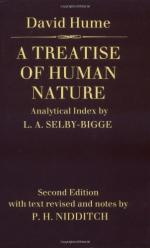But though motion and darkness, either alone, or attended with tangible and visible objects, convey no idea of a vacuum or extension without matter, yet they are the causes why we falsly imagine we can form such an idea. For there is a close relation betwixt that motion and darkness, and a real extension, or composition of visible and tangible objects.
First, We may observe, that two visible objects appearing in the midst of utter darkness, affect the senses in the same manner, and form the same angle by the rays, which flow from them, and meet in the eye, as if the distance betwixt them were find with visible objects, that give us a true idea of extension. The sensation of motion is likewise the same, when there is nothing tangible interposed betwixt two bodies, as when we feel a compounded body, whose different parts are placed beyond each other.
Secondly, We find by experience, that two bodies, which are so placed as to affect the senses in the same manner with two others, that have a certain extent of visible objects interposed betwixt them, are capable of receiving the same extent, without any sensible impulse or penetration, and without any change on that angle, under which they appear to the senses. In like manner, where there is one object, which we cannot feel after another without an interval, and the perceiving of that sensation we call motion in our hand or organ of sensation; experience shews us, that it is possible the same object may be felt with the same sensation of motion, along with the interposed impression of solid and tangible objects, attending the sensation. That is, in other words, an invisible and intangible distance may be converted into a visible and tangible one, without any change on the distant objects.
Thirdly, We may observe, as another relation betwixt these two kinds of distance, that they have nearly the same effects on every natural phaenomenon. For as all qualities, such as heat, cold, light, attraction, &c. diminish in proportion to the distance; there is but little difference observed, whether this distance be marled out by compounded and sensible objects, or be known only by the manner, in which the distant objects affect the senses.
Here then are three relations betwixt that distance, which conveys the idea of extension, and that other, which is not filled with any coloured or solid object. The distant objects affect the senses in the same manner, whether separated by the one distance or the other; the second species of distance is found capable of receiving the first; and they both equally diminish the force of every quality.




